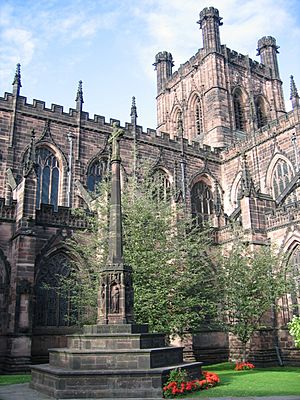Chester War Memorial facts for kids

The Chester War Memorial is a special monument located in the grounds of Chester Cathedral in Chester, England. It was designed by Frederick Crossley and Thomas Rayson. This memorial helps us remember the brave people from Chester who lost their lives in the two big World Wars. It's also a "listed building," which means it's an important historical structure protected by law.
Contents
How the Memorial Was Built
Planning the Memorial
After World War I ended in 1918, the people of Chester wanted a way to remember those who had died. In 1919, the Chester City Council created a special committee to decide what kind of memorial to build.
Some ideas were suggested, like building new public spaces, but these were too expensive. William Beswick, whose father was a county architect, offered to draw two designs for free. One design was for outside the Town Hall, and another for outside the King's School. Both were liked by the committee. There was also an idea to rebuild the old Chester High Cross. However, the King's School didn't want a memorial on their land, and the City Council rejected the other two plans.
Finding the Right Design
After a public meeting, everyone agreed that the memorial should be a cross and placed in the city center. A famous architect named Giles Gilbert Scott was asked to design a monument for the cathedral grounds. His design included a figure of Saint Michael under a cross, all beneath a roof-like structure. It would have been almost 12 meters (about 39 feet) tall and cost about £4,000. The committee approved it, but the dean of the cathedral said no, possibly because it was too tall.
The committee then asked Scott for a simpler design, like a cross on steps, which is common for market crosses in England. This design would have cost £2,500, but the committee still rejected it.
The Winning Design
Finally, the committee decided to hold a competition for a memorial cross to be placed near the cathedral, costing less than £2,000. In 1921, out of 23 entries, the design by Frederick Crossley and Thomas Rayson was chosen. The total cost of building the monument was £1,540.
The figures on the monument were sculpted by Alec Miller. The building work was done by W. Haswell and Sons of Chester. The memorial was officially revealed on May 24, 1922, by two mothers who had lost their sons in the war. The Bishop of Chester blessed it. After World War II, another message was added to remember those who died in that war too.
What the Memorial Looks Like
Materials and Size
The Chester War Memorial is made from red sandstone from a quarry in Delamere. This stone matches the outside of the cathedral. The monument stands about 9.75 meters (about 32 feet) tall.
Design Details
It has a base with four steps, shaped like a hexagon. From this base, a block called a plinth rises up, supporting a cross. Around the plinth, there are special carved spaces called niches. Inside these niches are figures of six saints:
- Werburgh: The patron saint of Chester.
- George: The patron saint of England.
- Maurice: A warrior saint, representing soldiers.
- Alban: A soldier and the first British martyr.
- David: The patron saint of Wales, as many people in Chester are from Wales.
- Michael: The archangel from the Bible who fought against evil.
The Inscription
On the fourth step of the base, there is an important message carved into the stone:
- ERECTED BY A GRATEFUL CITY
- IN HONOUR OF HER SONS
- WHO GAVE THEIR LIVES FOR
- THEIR COUNTRY IN THE
- GREAT WAR 1914–1918
- THEIR NAMES ARE ENGRAVED
- ON TABLETS OF BRONZE IN
- THE TOWN HALL AND THEIR
- IMPERISHABLE MEMORY
- IN THE HEARTS OF THEIR
- FELLOW CITIZENS.
On the west side of the third step, the dates "1939–1945" are carved. These dates remember those who died in the Second World War.
Listed Building Status
The monument was officially recognized as a Grade II listed building on August 6, 1998. This means it is considered a "building of national importance and special interest" and is protected. In 2012, it was described as being in "generally good" condition, with only small damage to some of the figures.

